| Columns Retired Columns & Blogs |
Mark Levinson No.436 monoblock power amplifier Measurements
Sidebar 3: Measurements
One difference between a modestly priced amplifier and something like the Mark Levinson No.436 is that the latter will run forever without overheating. Following the usual preconditioning period of driving one-third power into 8 ohms for one hour, the No.436's internal heatsinks were too hot to touch, but its cooling fan hadn't come on, and its chassis was merely warm.
The voltage gain was the same through the unbalanced and balanced inputs, at 26.75dB into 8 ohms. (Pins 1 and 3 of the balanced XLR jack were shorted with the supplied jumper when the unbalanced RCA jack was used.) Neither input inverted absolute polarity, and the input impedance was to specification over most of the audioband, at 49.5k ohms unbalanced and 99k ohms balanced. This did drop at 20kHz, however, to 18.3k ohms and 36.6k ohms, respectively, but this is still high enough not to give problems with preamp matching.
The output impedance was 0.09 ohm at 20Hz and 1kHz, rising inconsequentially to 0.11 ohm at 20kHz. (This figure includes the 6' of speaker cable used in the testing.) As a result, the Ohm's Law modification of the No.436's frequency response by the speaker impedance will be minimal. This can be seen in fig.1, where it reaches a maximum of ±0.1dB with our simulated loudspeaker. The amplifier's bandwidth is wide, with no rolloff visible at 10Hz and the ultrasonic output 3dB down at 149kHz, this true for both inputs. The No.436's reproduction of a 10kHz squarewave is therefore nicely square (fig.2).
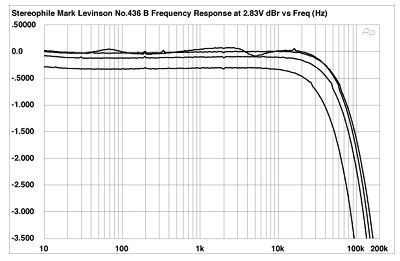
Fig.1 Mark Levinson No.436, balanced frequency response at (from top to bottom at 2kHz): 2.83V into simulated loudspeaker load, 1W into 8 ohms, 2W into 4 ohms, 4W into 2 ohms (1dB/vertical div., right channel dashed).
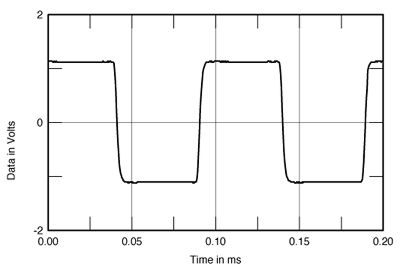
Fig.2 Mark Levinson No.436, small-signal 10kHz squarewave into 8 ohms.
The signal/noise ratio (ref. 1W into 8 ohms) was excellent, at 76.8dB, unweighted wideband, this improving to 90.3dB when A-weighted. The plot of the Levinson's small-signal THD+noise percentage against frequency (fig.3) shows almost no change with load impedance, other than the degree of the very slight rise above 20kHz. The absolute level is very low, and is actually dominated by noise below 10kHz.
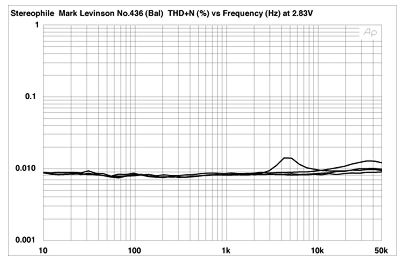
Fig.3 Mark Levinson No.436, balanced THD+N (%) vs frequency (from bottom to top at 2kHz): 2.83V into 8 ohms, simulated loudspeaker load, 4 ohms, 2 ohms.
The waveform of that distortion at low to moderate output powers is predominantly third-harmonic in nature (fig.4), though the second harmonic makes an appearance at high powers (fig.5). Intermodulation distortion with the demanding one-to-one mix of 19kHz and 20kHz tones was fairly low (fig.6), though it was hard to measure, the amplifier's protection circuitry cutting in after less than a couple of seconds of driving this signal at more than 100W into 8 ohms. In fact, any continuous high-frequency signal activated the protection if it approached 100W for more than a few seconds.
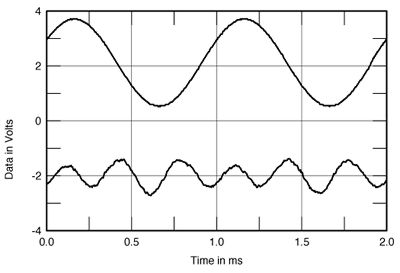
Fig.4 Mark Levinson No.436, 1kHz waveform at 59W into 8 ohms (top), 0.0026% THD+N; distortion and noise waveform with fundamental notched out (bottom, not to scale).
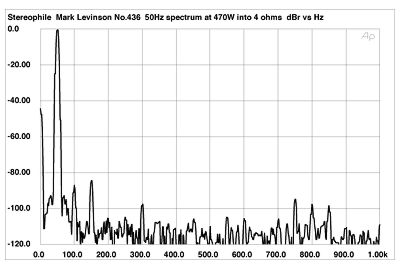
Fig.5 Mark Levinson No.436, spectrum of 50Hz sinewave, DC-1kHz, at 470W into 4 ohms (linear frequency scale).
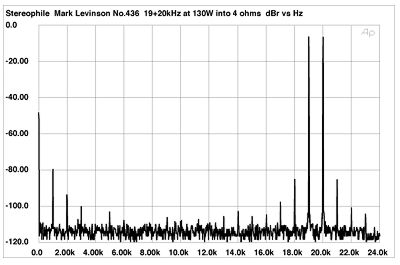
Fig.6 Mark Levinson No.436, HF intermodulation spectrum, DC-24kHz, 19+20kHz at 130W into 4 ohms (linear frequency scale).
While I can confidently predict that the No.436 will never see this combination of signal and level with music, this behavior did make me wonder if Madrigal's engineers were merely being overcautious—probably a good idea, given the possibility of the No.436 being used in fit'n'forget custom installations—or hiding something. But such suspicions are undoubtedly unfair.
One thing's for sure—the No.436 is a powerhouse. When I performed the measurements, my wall voltage was, admittedly, rather high: 126.9V AC, dropping to 123.7V when the amplifier was clipping into 2 ohms. But fig.7 shows that it delivered no less than a continuous 500W into 8 ohms at 1% THD (27.0dBW), 890W into 4 ohms (26.5dBW), and 1.5kW into 2 ohms (25.75dBW). All of these figures are well above the amplifier's specified powers. Peculiarly, this graph reveals that, at high powers, the No.436 is actually more linear into 4 ohms than it is into 8.
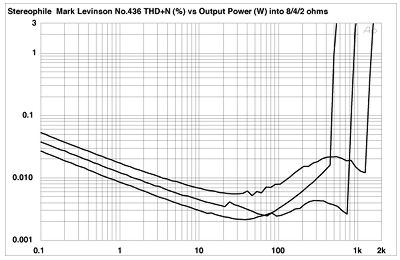
Fig.7 Mark Levinson No.436, distortion (%) vs 1kHz continuous output power into (from bottom to top at 10W): 8 ohms, 4 ohms, 2 ohms.
The Mark Levinson No.436's measurements reveal it to be a thoroughly modern solid-state amplifier.—John Atkinson
- Log in or register to post comments




































